A perfectly plush, soft, classic vanilla cake recipe made entirely from scratch! It’s so simple to make, and tastes much better than a box mix! Recipe includes a how-to video.
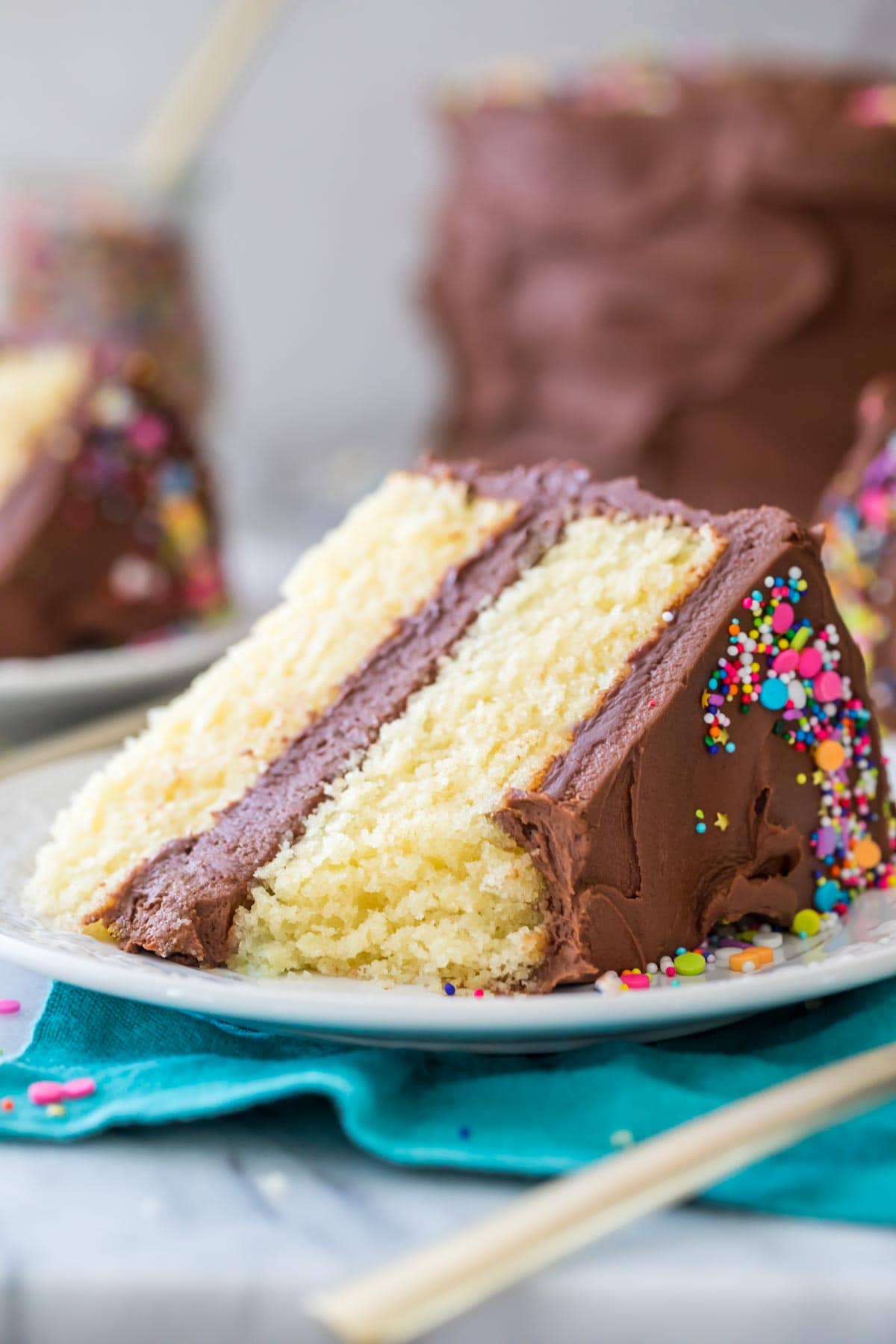
A Classic Vanilla Cake, Made Entirely From-Scratch
Every baker needs a solid vanilla cake recipe in their repertoire, and today’s recipe is just that.
It’s soft, plush, and perfectly moist. Not to be confused with my white cake, this recipe is a beautiful pale golden color and distinctly vanilla flavored. It pairs beautifully with any frosting, although a traditional chocolate frosting is my favorite finish!
Like my chocolate cake, this has been one of my most popular recipes for years (and you may recognize it as the base for both my pineapple upside-down cake and my marble cake). It’s a simple, classic, and incredible vanilla cake. So many of you have tried and loved this recipe, and while the recipe remains exactly the same, I thought it was about time for a facelift with new photos and a new video.
The flavor and texture of this cake is so much better than box-mix, and the preparation is almost as easy. I’ve included a few tips below to help you be successful, so make sure to read all the notes before you get started.
What You Need
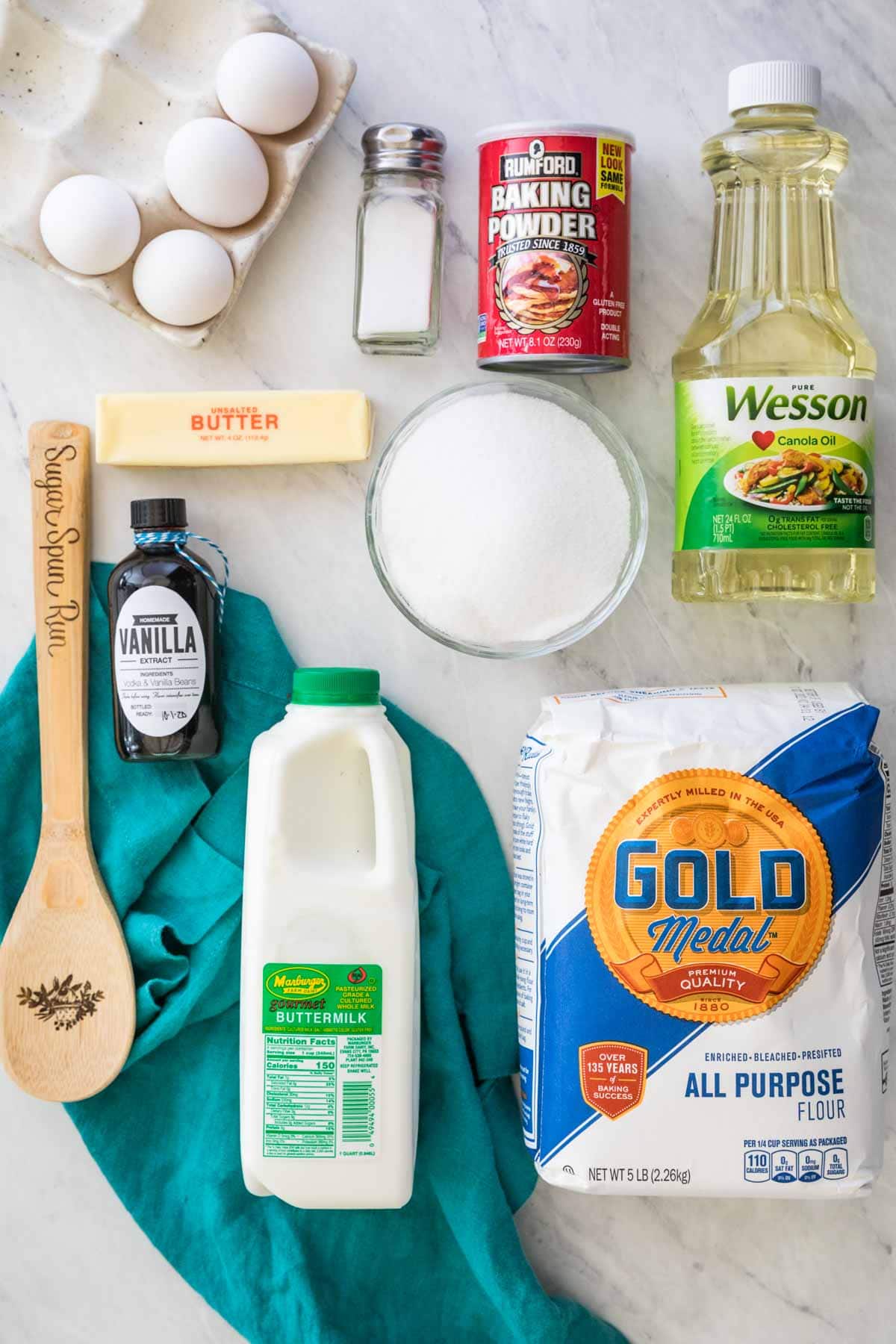
After testing many versions and combinations of ingredients, I’ve found that a good vanilla cake needs the following ingredients:
- Oil AND butter. A blend of these two ingredients gives the cake the best possible flavor and texture. Butter provides flavor while oil adds moisture and keeps it from being too dry. A cake made with all oil would be moist but lacking in flavor, and an all-butter cake may have a more buttery taste, but would be more dry. Any neutral cooking oil will work here, but I typically recommend using either vegetable or canola oil. For the butter, unsalted is best so we have maximum control over the flavor of the cake
- Sugar. Plain granulated sugar works best. Brown sugar would add moisture, but would detract from the classic vanilla flavor and even weigh down the cake a bit.
- Eggs. You’ll need four eggs, and it’s best if you bring them to room temperature before adding them (this helps them incorporate into the batter more evenly).
- Vanilla. You can’t have vanilla cake without vanilla! I recommend using a good quality vanilla extract, so if you’ve got a batch of homemade vanilla extract, use it here!
- Flour. I developed this vanilla cake recipe to be work with all-purpose flour and that’s what I always use. However, you *could* use cake flour instead. To substitute by weight, you would use the same amount, but if you are using measuring cups you will need to substitute your flour properly.
- Baking powder. I know a tablespoon of baking powder may seem like a lot, but that’s not a typo. Always make sure your baking soda is fresh and avoid using a generic brand, which I’ve had mixed results with in the past.
- Salt. You can just use plain table salt.
- Buttermilk. I strongly recommend using full-fat buttermilk for the best flavor and texture. While I do have a buttermilk substitute, it doesn’t really make this vanilla cake quite as moist and flavorful as I like it to be, so now I strictly recommend using real buttermilk. And no, you do not *need* to have baking soda in a recipe in order to use buttermilk; we’re using it for its moisture and flavor here!
SAM’S TIP: One of the biggest mistakes you can make with this recipe is neglecting to measure your flour properly. If you over or under-measure your flour, your cake will not turn out right! Use the right method, be as precise as possible, and use a kitchen scale if you have one.
Remember, this is just an overview of the ingredients I used and why. For the full recipe please scroll down to the bottom of the post!
How to Make Vanilla Cake
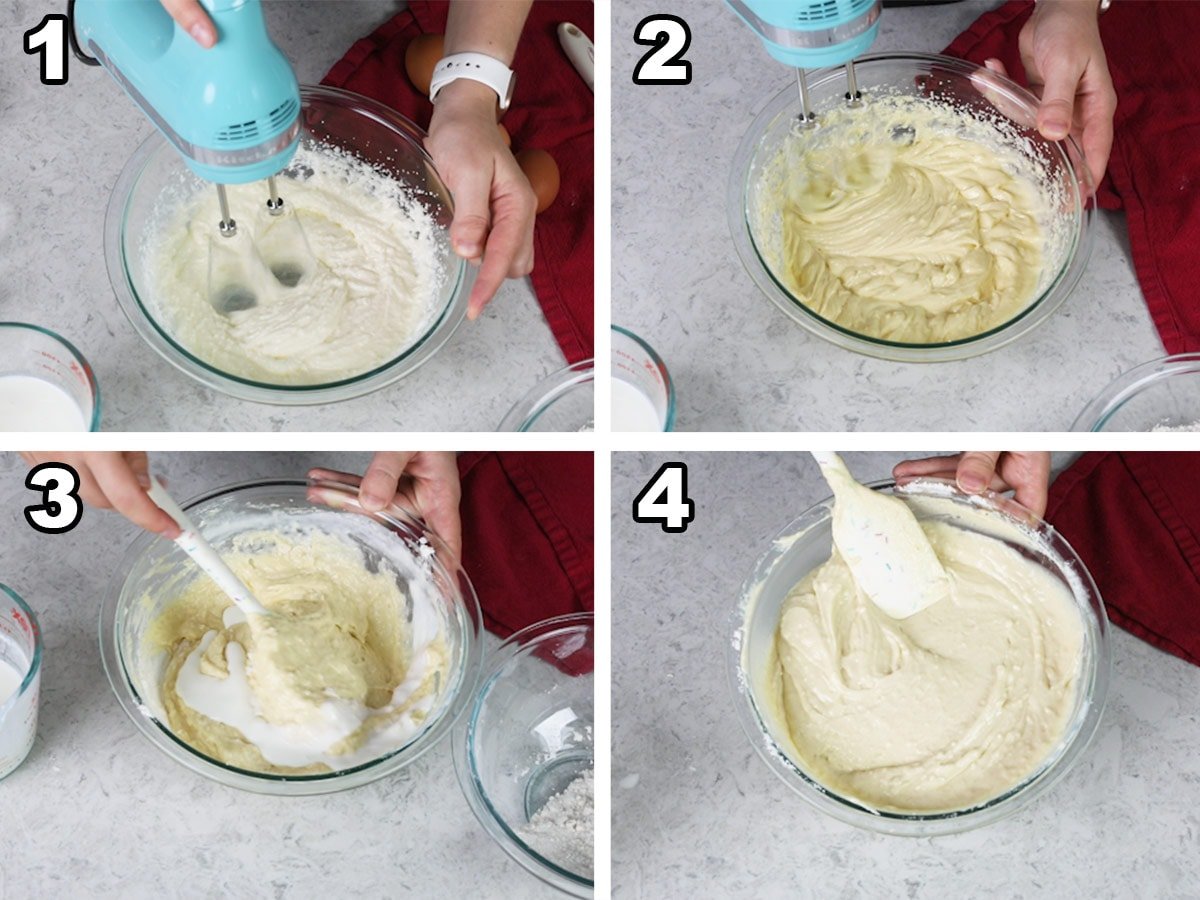
- Cream the butter, oil, and sugar in the bowl of a stand mixer.
- Add the eggs one at a time, beating well after each addition. Then, add your vanilla and stir to combine.
- Combine your dry ingredients in a separate bowl, then add about ⅓ of the mixture into your bowl. Use a spatula to gently stir until just combined. Follow this with about ½ of your buttermilk, and stir again until just combined. .
- Add ½ of the remaining dry ingredients stir, and then add the remainder of the buttermilk. Finish with the final portion of dry ingredients and use your spatula to make sure the batter is smooth–do NOT overmix!
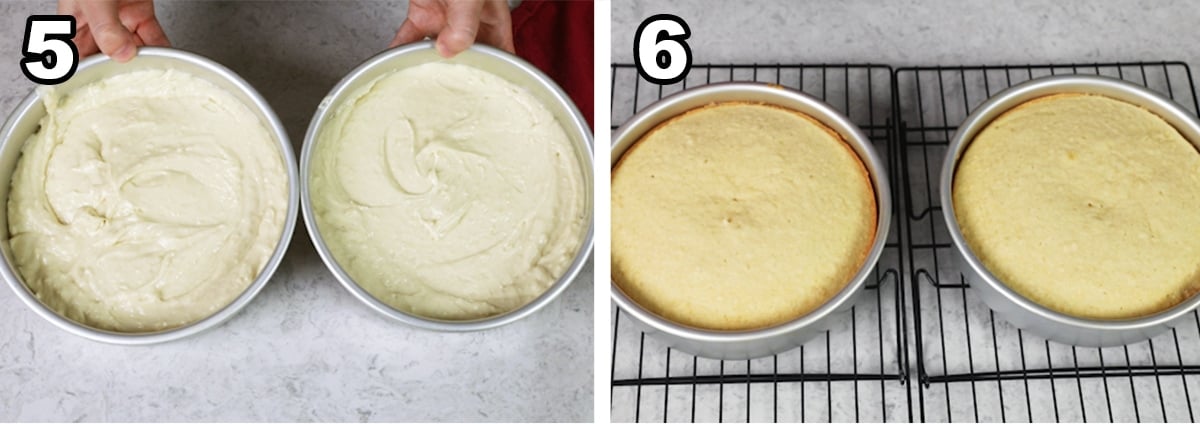
- Divide the batter evenly into two greased baking pans.
- Bake, then use a toothpick to test for doneness. Let the cakes cool in their pans a bit before inverting onto a cooling rack, where they’ll need to cool completely before frosting.
SAM’S TIP: While a toothpick that comes out clean indicates a fully baked cake, an over-baked cake will also yield a clean toothpick. It’s best to pull your vanilla cake out of the oven when a toothpick shows moist crumbs!
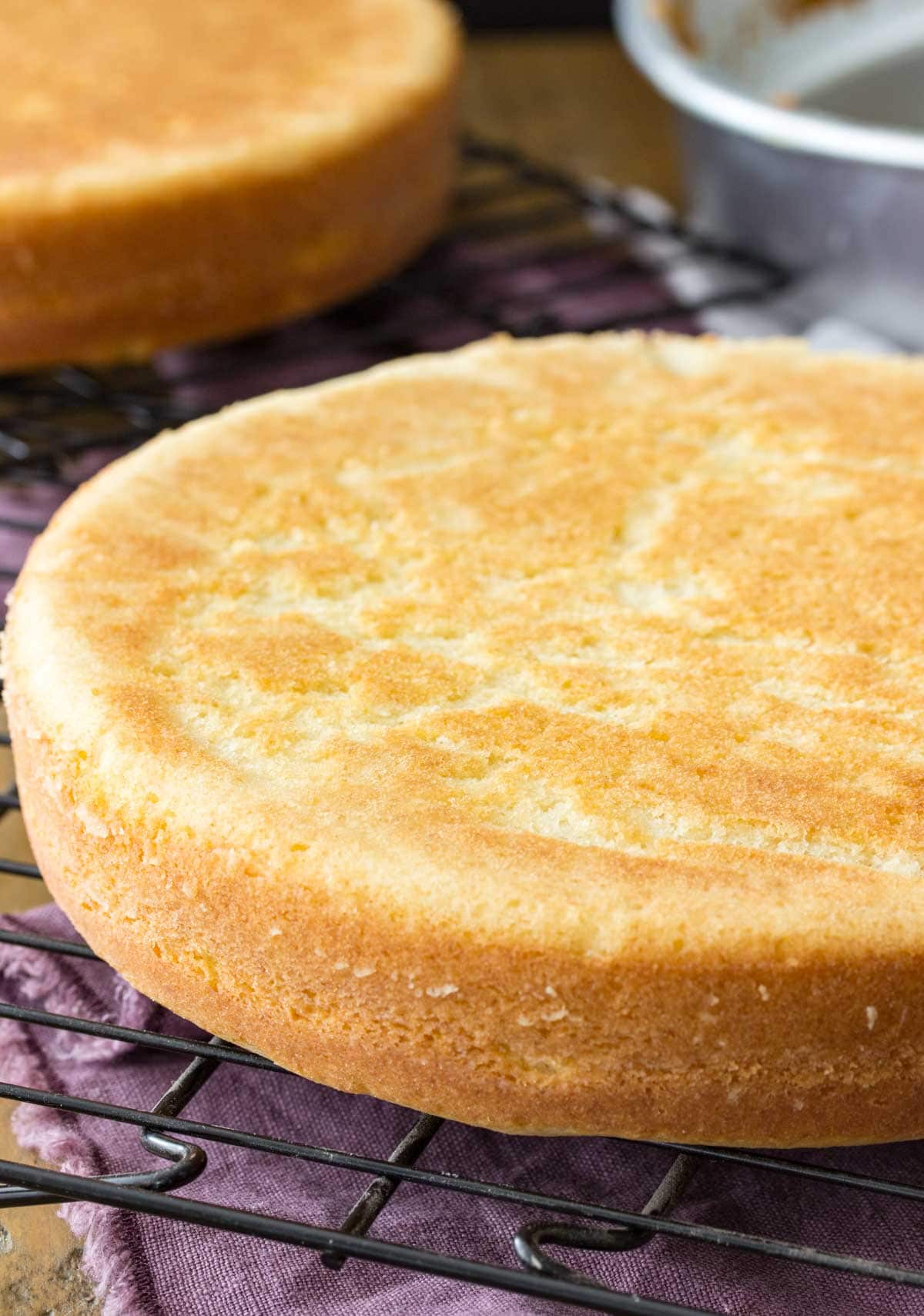
Frequently Asked Questions
Yes! This vanilla cake recipe will make 24 vanilla cupcakes. I’ve included instructions for cupcakes in the recipe notes.
A cake that has been over-baked or one in which too much flour was used will be crumbly when cut into. If you invert the cake too soon or try to handle it while it’s too warm, this could also make it break.
Cakes made from scratch require a bit more care and technique than those that come from a box-mix. When making any cake from scratch, take care to not over-mix, over-bake, or use too much flour, or the cake can end up tasting like cornbread. This applies to any cake that is made from scratch, not just this recipe!
What causes dry cake?
Dryness is typically the biggest complaint bakers have when making a cake from scratch, so I thought this FAQ deserved its own space. There are three main causes for a dry cake: over-measuring the flour (addressed above), over-mixing, and over-baking.
- Do not over-mix your batter! Mixing the batter properly can be tricky and this is often where most mistakes are made with homemade cakes. To avoid over-mixing, thoroughly cream together the wet ingredients, particularly the butter, sugar, oil, and eggs. I highly recommend using an electric mixer for this step! However, once you get to the point of combining your wet and dry ingredients, you need to be gentle and fold by hand using a spatula. Alternate adding the dry ingredients and the buttermilk, folding thoroughly, but not aggressively. The batter will be smooth and mostly cohesive; there may be some small lumps remaining, but that’s fine! Also, remember that while over-mixing can make your vanilla cake both dry and dense, under-mixing has its own risks and should be avoided as well!
- Do not over-bake your cake! Even a minute too long in the oven can cause a cake to be too dry and dense. When baking, place your cake pans on the center rack of your oven and always make sure your oven is running at the proper temperature (most ovens do not, so keep a thermometer in yours!). Don’t check your vanilla cake too early (that can make it sink!), but do keep an eye on it. When your cake is ready to come out of the oven, the center should spring back if lightly touched–it should not deflate or appear jiggly. You can also use the toothpick test to check for doneness. To do this, simply insert a toothpick in the center of your cake; it’s done if the toothpick comes out with a few moist crumbs (not wet batter). Once your vanilla cake is done, let it cool in the pan for only 10-15 minutes before running a knife around the edge and inverting it onto a cooling rack to cool completely.
SAM’S NOTE: Under-mixing your cake batter, not baking the cake for long enough, or opening the oven door too frequently while the cake bakes can cause the cake to sink as it cools.
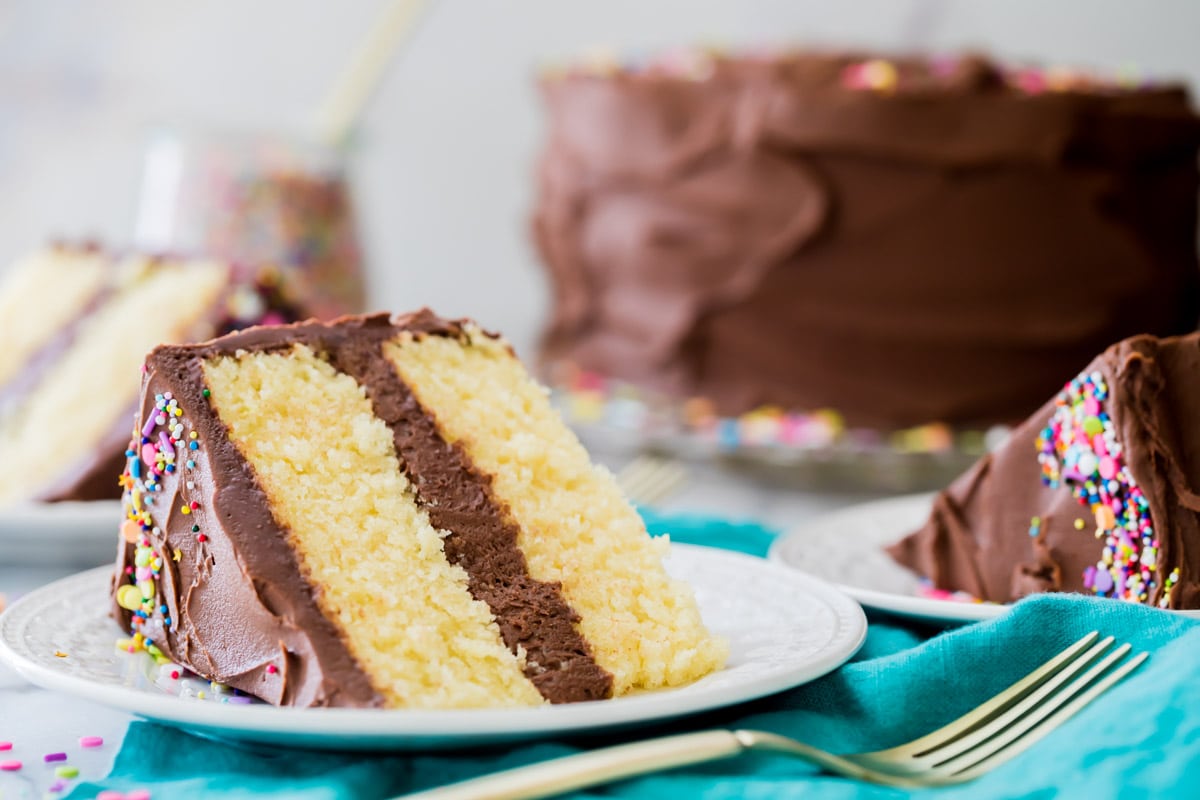
Enjoy!
Let’s bake together! I’ll be walking you through all the steps in my written recipe and video below! If you try this recipe, be sure to tag me on Instagram, and you can also find me on YouTube and Facebook
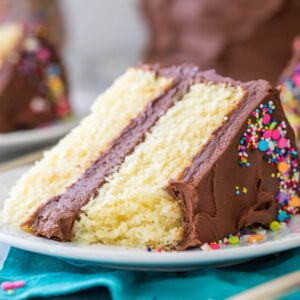
Vanilla Cake
Ingredients
- ½ cup (113 g) unsalted butter softened to room temperature
- ½ cup (120 ml) avocado, canola or vegetable oil¹
- 1 ½ cup (300 g) granulated sugar
- 4 large eggs room temperature preferred
- 1 Tablespoon vanilla extract
- 3 cups (375 g) all-purpose flour²
- 1 Tablespoon baking powder
- ½ teaspoon salt
- 1 ¼ cup (300 ml) buttermilk room temperature preferred
- 1 batch Chocolate Frosting click link for recipe, or use one of the other frostings recommended in the notes below
Recommended Equipment
Instructions
- Preheat oven to 350F (177C) and prepare two deep 8" round cake pans³ by lining the bottoms with parchment paper and lightly greasing the sides. Set aside.
- In the bowl of a stand mixer (or in a large bowl using an electric mixer) cream together the butter, canola oil and sugar until creamy and well-combined.½ cup (113 g) unsalted butter, ½ cup (120 ml) avocado, canola or vegetable oil¹, 1 ½ cup (300 g) granulated sugar
- Add eggs, one at a time, beating until thoroughly combined after each addition.4 large eggs
- Stir in vanilla extract.1 Tablespoon vanilla extract
- In a separate, medium-sized bowl, whisk together flour, baking powder, and salt.3 cups (375 g) all-purpose flour², 1 Tablespoon baking powder, ½ teaspoon salt
- Using a spatula and gently hand-mixing, alternate adding flour mixture and buttermilk to the butter mixture, starting and ending with flour mixture and mixing until just combined after each addition. The batter should be thoroughly combined, but there may be some small lumps in the batter and avoid over-mixing (and do not use your electric mixer or stand mixer for this step).1 ¼ cup (300 ml) buttermilk
- Evenly divide batter into your prepared cake pans, and bake on 350F (175C) for 30-35 minutes. When the cake is done, the surface should spring back to the touch and a toothpick inserted in the center should come out mostly clean with few moist crumbs (no wet batter).
- Allow cakes to cool in their cake pans for 10-15 minutes before inverting onto cooling rack to cool completely before frosting.
- Frost cake using my chocolate frosting (or see notes for other favorite frosting options) and decorate with sprinkles (if desired).1 batch Chocolate Frosting
Notes
¹Cooking oil
You may use any neutral cooking oil instead of vegetable or canola oil. I generally don’t recommend olive oil, which is heavier and has a distinct flavor that could affect the end taste result of your cake.²Cake Flour
You may substitute cake flour for all-purpose flour. Use 3 ⅓ cups or 375g of cake flour.³Different size baking pans
- 13×9″ pan: This recipe makes enough for one 13×9″ baking pan. Readers have reported the approximate bake time is 30 minutes.
- Two 9″ pans: Readers have reported this cake takes approximately 25 minutes to bake in 9″ pans.
- Bundt pan: Readers have reported this cake takes approximately 40-45 minutes to bake in a bundt pan
Vanilla Cupcakes:
This recipe will make approximately 24 vanilla cupcakes. Fill cupcake liners no more than ¾ of the way full. Bake on 350F for 17-18 minutes or until a toothpick inserted in the center comes out with a few moist crumbs or clean.Frosting Options
The chocolate frosting I linked to in the ingredients is my favorite pairing with this cake, but here are some other great options:Video note
In the video I mistakenly say to add more buttermilk than is necessary. The written recipe is correct with 1 ¼ cups of buttermilk.Nutrition
Nutritional information is based on third-party calculations and should be considered an estimate only. Actual nutritional content will vary based upon brands used, measuring methods, cooking method, portion sizes, and more.

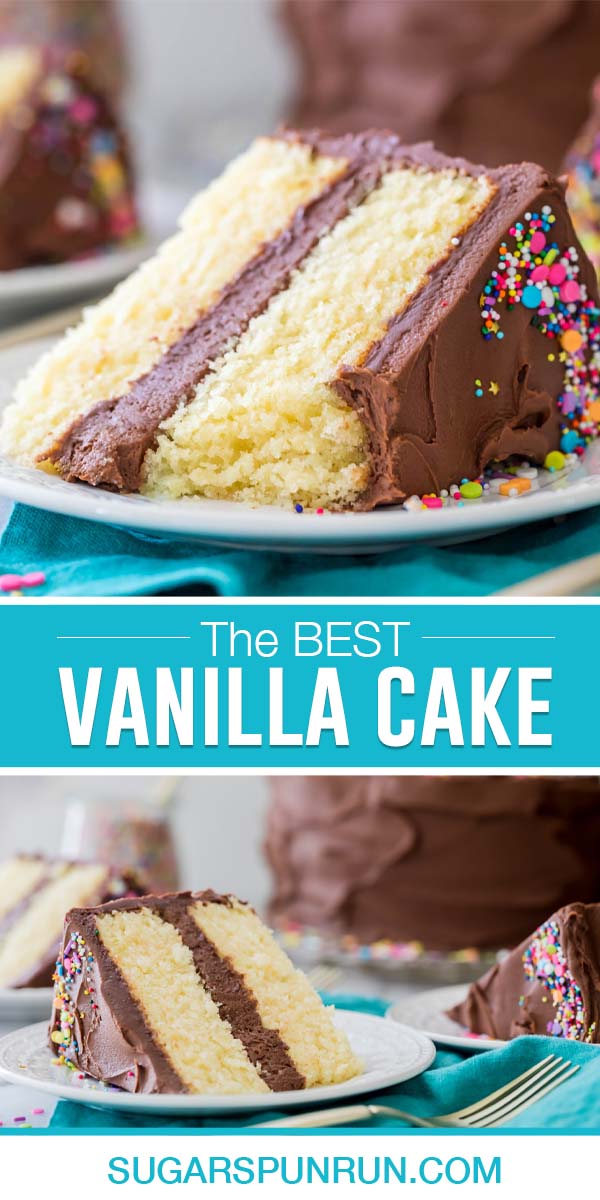
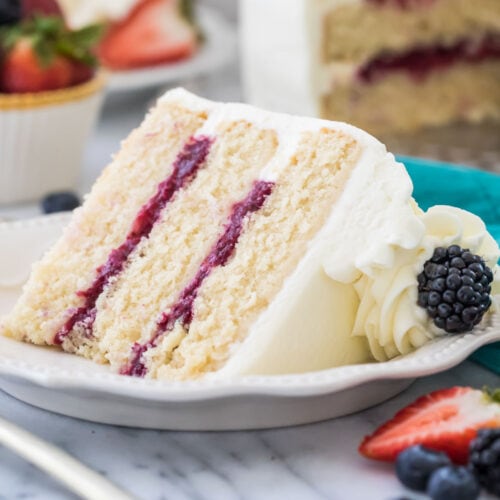
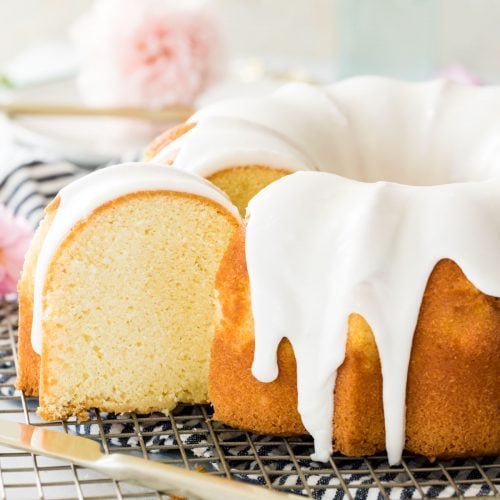
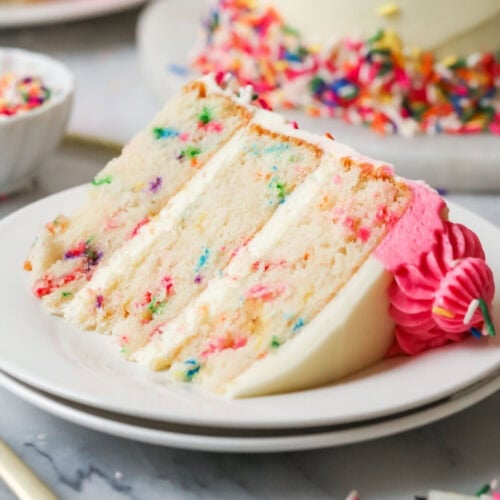
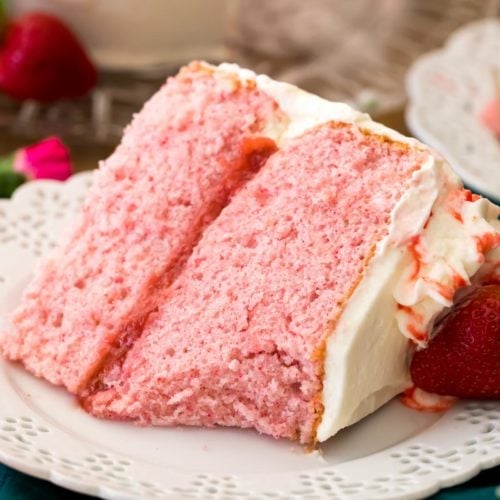
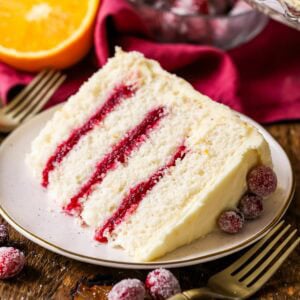

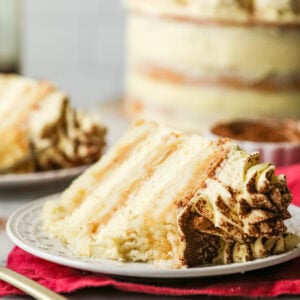
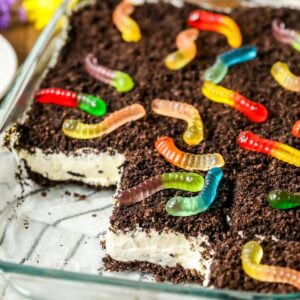
Zamo
Hi I used this recipe with brown sugar mad self raising flour and it turned out great.Thank you
Debbie
Hi Sam
Is it possible to use self raising flour?, if so would I need to still add any baking powder?, I would like to use castor sugar too, do I just use the same amount as the granulated ?
Emily @ Sugar Spun Run
Hi Debbie! We do not recommend self-rising flour in this recipe. Substituting castor sugar for the granulated should work fine–it will be the same amount. Hope that helps!
deb
Hi Sam
Im wanting to try this vanilla cake recipe and to halve it for just one pan. Is it possible to use castor sugar in the batter instead of granulated?, if so how many grams of castor sugar would I need please? would the castor sugar affect the cake texture if I used it?
Emily @ Sugar Spun Run
Hi Deb! Castor sugar should work fine. It will be an even substitute. Enjoy!
Mel Forristall
Love this recipe! I use it all the time for my business. It’s a great base for mix ins too! I have question, I do notice I get holes in my layers, what can I do to prevent this? I’m definitely not overmixing the batter, the cake is always moist and fluffy. Should I sift my dry ingredients? My batter always looks slightly lumpy like yours in the video but I am scared to keep mixing and overmixing. Any ideas?
Emily @ Sugar Spun Run
Hi Mel! It actually sounds like you might be under-mixing your batter. Sifting the dry ingredients wouldn’t hurt though 😊
Tisha Stein
made this today and I must say it is a very dense cake, would definitely not recommend, I believe adding only baking powder and 1 TBS at that is way to much, you could try too.. nope bad recipe God Bless
Sam
I’m so sorry to hear this happened, Tisha! A dense cake is likely the result of over-mixing or over-baking. 🙁
Celina
Thank you so much for your lovely recipes friend, I tried it and I loved it. 😍 Much love from Kenya.
Carole
Awesome recipe!
Emily @ Sugar Spun Run
We’re so happy you like it, Carole! 😊
Bob
Mine tasted pretty gross and almost like corn bread. I followed the recipe exactly and it still came out bad. The frosting also tasted like butter, adding to the cornbread flavor. Any ideas on what I might have done wrong?
Sam
Hi Bob! I’m so sorry to hear this happened! The most likely causes of a cornbread like flavor/texture is over-baking the cake. The sugar and vanilla should do a good job combining with the butter flavor for the frosting so I’m not sure what happened there. 🙁
Monet
Hi, would I be able to double this recipe for a 3 layered 10inch cake?
Sam
Hi Monet! That could work. Your layers may be slightly thinner, but it should work. Be careful to not over-mix the batter. 🙂
Kim
Great cake and thank you so much for including the ingredients needed for each step – that’s SO helpful. Usually I’m scrolling up for ingredients, then scrolling back down for the next step and it gets tiring.
Emily @ Sugar Spun Run
It’s such a timesaver! So glad you enjoyed the recipe, Kim 😊
Christina Leatha
We are dairy free and I used all avocado oil in place of the butter; they still turned out fantastic. I love that they aren’t sickeningly sweet, the warm vanilla flavor really comes through.
Emily @ Sugar Spun Run
Thanks for letting us know how that worked for you, Christina! Enjoy ☺️
Madelyn
Hello, I want to try this recipe, it looks delicious. But usually when using buttermilk, yogurt or sour cream baking soda should be used instead of baking-powder as these ingredients activate the baking soda. Have you tried it? I ask because you’re using so much baking powder. Thank you in advance.
Emily @ Sugar Spun Run
Hi Madelyn! After lots and lots and LOTS of testing, Sam found this was the best combination. While the baking powder isn’t reacting with the buttermilk, the buttermilk does provide a much better flavor and texture. Hope that helps! 🙂
Jamie
Hi Sam,
I am not a big fan of buttermilk. I followed this recipe once before using buttermilk hoping I wouldn’t taste the tang of the buttermilk in it. But I could definitely taste the buttermilk in it. Could I use whole milk instead?
Thanks!
Raquel
Awesome recipe! Made a few tweaks to use for a pineapple upside down cake and it came out perfect!
Deb
Sam,
In your notes above the recipe you state “Baking powder. I know a tablespoon of baking powder may seem like a lot, but that’s not a typo. Always make sure your baking soda is fresh and avoid using a generic brand, which I’ve had mixed results with in the past.” I assume you meant make sure your baking powder is fresh and avoid using a generic brand? I do use Trader Joes baking powder as it has worked great for pancakes, etc. but again I am assuming you would consider that a generic name? Thank you for your help!
Emily @ Sugar Spun Run
Hi Deb! Thanks for pointing that out–it should be baking powder. Always follow the recipe (at the bottom of the post) in case of any discrepancies. And yes, we would consider that a generic brand. Hope that helps!
Harindi
Hi Sam, I have been following your recipes for a while now and thank you very much! I have a small question, what’s the difference between adding sour cream Vs Buttermilk in cakes?
Emily @ Sugar Spun Run
They are very similar, but sour cream has more fat and is a bit richer, which can lead to more tender, flavorful results. We’re so happy you’re enjoying our recipes! ❤️
Bri
The cake was a perfect base for my dessert. But also, I LOVE how you added the measurements to the actual instructions! It’s incredibly helpful and I’m sad more people don’t do it. Thank you!!
Sam
I’m so glad that’s helpful, Bri! Thank you so much for trying my recipe! ❤︎
Rachel K
In your video you state that you are using 1 1/2 cups of buttermilk however in your recipe it says 1 1/4 and when making your homemade buttermilk you state it is 1 cup. I’m a little confused 😕
Sam
Hi Rachel! The written recipe is correct for 1 1/4 cups. The homemade buttermilk recipe is just how to make a cup of buttermilk, you will need to scale that as needed according to the recipe you are using. I hope that helps!
Jamie Smith
Can i make night before? If so, do i need to refrigerate?
Emily @ Sugar Spun Run
Hi Jamie! It depends on your frosting; if your frosting needs refrigerated, the finished cake will need to be too. If you do end up storing the cake in the fridge, make sure you use an airtight container to prevent it from drying out. Hope that helps!
Jamie Smith
I was planning on making the chocolate frosting you linked the day of her birthday. But making the cake the day before and leaving it at room temp for one night, is that ok?
Also, Would you consider a glass cake stand with a lid as airtight? Trying to save money and not buy a new container 😂
Emily @ Sugar Spun Run
Hi Jamie! So with that frosting, you can keep the frosted cake at room temperature for 2 days, but it would need to be refrigerated after that. You will be fine to make the cake layers the night before and let them sit at room temperature–just wrap in plastic or store in an airtight container. And yes, the glass cake stand will work fine 😊
Jax
Hi, I only have one cake pan that is the same size. is this a recipe where I can put half of it in the fridge while the rest of it bakes? and then bake the other half after?
Emily @ Sugar Spun Run
Hi Jax! The batter will be fine to sit on the countertop while the first cake bakes. No need to refrigerate. Enjoy! 🙂
Kay
Hey Sam, thanks a million for this recipe, it’s great! I wanted to know could I bake this cake and freeze it? I’ve got a busy week and won’t have time to bake the day before. Thanks!
Sam
Hi Kay! This cake does well being frozen. 🙂